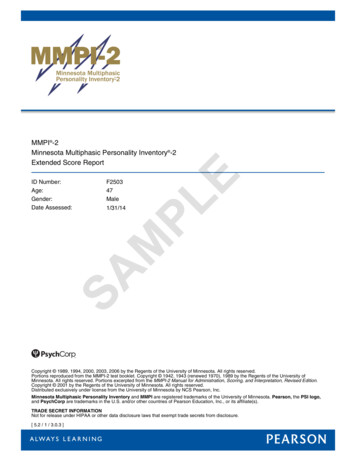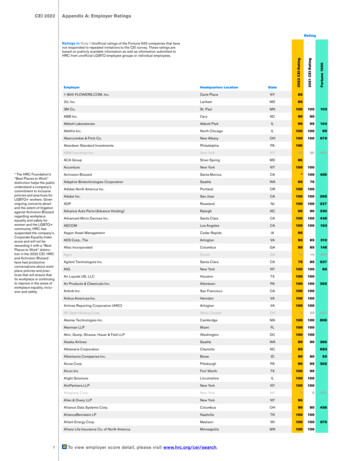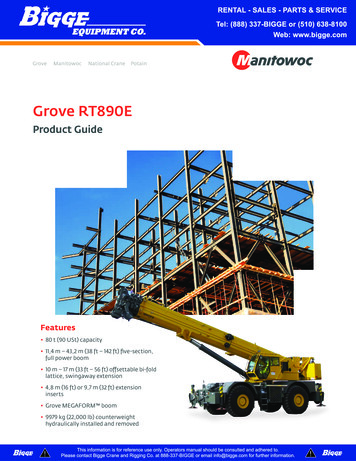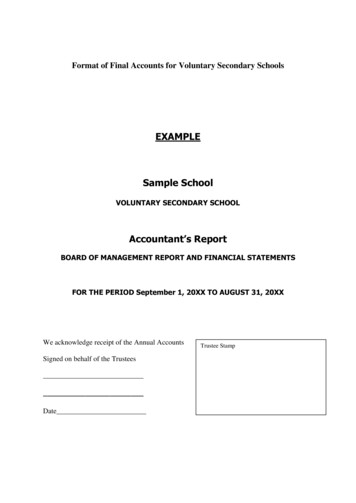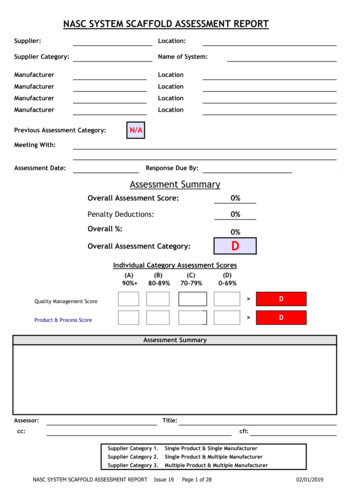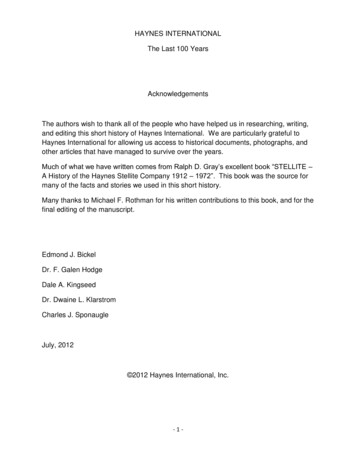
Transcription
HAYNES INTERNATIONALThe Last 100 YearsAcknowledgementsThe authors wish to thank all of the people who have helped us in researching, writing,and editing this short history of Haynes International. We are particularly grateful toHaynes International for allowing us access to historical documents, photographs, andother articles that have managed to survive over the years.Much of what we have written comes from Ralph D. Gray’s excellent book “STELLITE –A History of the Haynes Stellite Company 1912 – 1972”. This book was the source formany of the facts and stories we used in this short history.Many thanks to Michael F. Rothman for his written contributions to this book, and for thefinal editing of the manuscript.Edmond J. BickelDr. F. Galen HodgeDale A. KingseedDr. Dwaine L. KlarstromCharles J. SponaugleJuly, 2012 2012 Haynes International, Inc.-1-
HAYNES INTERNATIONALThe Last 100 YearsINTRODUCTIONHaynes International celebrates the 100th anniversary of its founding in October, 2012.Begun by Elwood Haynes, the company traces its origins back to a day in September,1912 when Haynes learned that he would be granted patents for two of his special alloyinventions. He immediately purchased property and constructed a building to housemelting furnaces for commercially producing the material he called STELLITE alloy. ByOctober, 1912 the “Haynes Stellite Works” was in business, with production actuallyunderway by December.The company began with just four workers, consisting of Haynes, his wife, his brotherin-law, and his 16 year old son March. March worked evenings and Saturdays as agrinder. Haynes has been described as much more of an “inventor” than abusinessman. While actively managing the manufacturing plant, he continued to spendtime researching new compositions for his STELLITE alloysAs with most new businesses, growth was slow during the early years. Equipmentinitially consisted of 16 gas-fired furnaces, each capable of melting 15 pounds of alloy.Three different grades of STELLITE alloy were produced and cast using graphite molds.Applications principally consisted of cutting tools for machining other materials. TheSTELLITE tools exhibited considerable advantage over tool steels, and became popularfor that reason.Annual sales for the new company were around 7,000 in 1913, growing to 48,000 by1915. It was in 1915 that the company structure underwent a significant change.Haynes agreed to incorporate the business with two local businessmen, RichardRuddell and James C. Patten. The Haynes Stellite Company was incorporated onOctober 26th, 1915.Patten was given responsibility for active management of the company, while Haynesfocused upon his alloy research. Under Patten’s leadership, sales growth began toaccelerate, and soon the company was selling more volume of product in a month thanpreviously had been sold in an entire year.From these beginnings grew the Haynes International we are all a part of today. Withsales of roughly 500 million, Haynes is in the top 0.2 % of all US companies. Ourproducts are utilized in essential applications throughout the USA and the world.Products made in Kokomo are used in parts for almost every commercial airplane thatflies today, as well as in military aircraft for the US and many of its allies.-2-
Our alloys enable the production of hundreds of drugs, from the latest cancer fightingagents to common aspirin. Alloys invented and produced by Haynes International flewon every Apollo and Space Shuttle flight, and are found in parts for most rockets used insatellite launches today.The following sections contain many examples of where Haynes International productshave been used, and reveal how critically important they are in both commercial andmilitary applications. Haynes International has been solving customer materialsproblems for 100 years, often providing solutions where no other materials would work.Each section marks some important internal or external event that shaped the history ofthe company and, in many cases, helped to define the Haynes International of today.A Tradition of Innovation Spanning a Century.True for the past 100 years. True for the next 100 years.-3-
THE EARLY YEARSThe beginning of Haynes International could easily be equated to a “Mom and Pop”operation, since the original four workers were Elwood Haynes, his wife Bertha, his sonMarch, and brother-in-law Harry Lanternman. Haynes, of course, was involved inseveral activities, including his work on the automobile. A tireless inventor, his researchwork around the turn of the 20th century involved finding a suitable spark plug electrodematerial for his automobile engines.Over the course of the next decade, Haynes experimented with various alloys, andbecame interested in finding a good material for cutlery, among other things. This workwas focused on alloys of cobalt and chromium, which he called his “Stellite” alloys. Heobtained patents in 1907 and continued his experimentation. In July of 1912, hesubmitted patent applications for alloys of cobalt and chromium with ternary andquaternary additions of tungsten and molybdenum. These patents were the origin ofthe materials that ultimately would become known today as the STELLITE alloys.Having found that an alloy of cobalt, chromium and tungsten had particularly goodhardness and wear resistance, properties, Haynes evaluated it as a tool material, andfound it to be far superior to anything then available. In May 1912, Haynes introducedthis STELLITE alloy as a tool material for use in his automobile plant. It became aninstant success, reducing some part machining times by more than half.Having returned home for the summer in 1912, and upon learning of the success of herfather's new alloy at the auto plant, Haynes' daughter Bernice urged her father topromote the new alloy for commercial use as lathe tools. When, in September, the USPatent Office informed him that he would be granted two patents for his latest work,Haynes immediately undertook to form Haynes Stellite Works in order to do just that.After acquiring a building on Union Street in Kokomo, the company beganmanufacturing product. Delivery of customer orders began by December, 1912. All ofthe products made at this time were castings of the cobalt-base alloys. The largestmarket was for lathe tools used for machining steel, with some additional use in cutlery.The company grew sales over the next few years from 7,000 in 1913 up to 48,000 in1915. It was in 1915 that the company structure underwent a significant change.Haynes agreed to incorporate the business with two local businessmen, RichardRuddell and James C. Patten. The Haynes Stellite Company was incorporated onOctober 26th, 1915.Haynes’ partner, James C. Patten was chosen to actively manage the company. Pattenwas an aggressive manager and this was to be a big turning point for the company.Sales increased dramatically and a new building was added next to the existing plant. In1916 sales rose to around 1,000,000.-4-
The use of STELLITE alloys for lathe cutting tools was largely responsible for this rapidgrowth. Stellite cutting tools became so popular that machinists using them wouldoften take their tools home at night for safekeeping (since it would be impossible forthem to make their quotas if they had to use the more common tool steel tools). Thisapplication set the stage for arguably the most important contribution the Haynes StelliteCompany was to make to the country in its first decade of existence.It was, in fact, during World War I that the true strategic importance of the company’salloys became clearly apparent. In this wartime period, demand for industrial productionincreased dramatically. This was especially true for the manufacture of military aircraftengines. The most important aircraft engine of WWI was the Liberty engine:“The Liberty 400-horsepower (298-kilowatt) V-12, air-cooled engine . wasone of the war's most powerful engines and one of the workhorses of thewar. Designed to be mass-produced with interchangeable parts, the Libertybecame the standard wartime aircraft engine, produced by Packard, Lincoln,Ford, General Motors (Cadillac and Buick), Nordyke, and Marmon. It wasused most often on the DH-4, the only U.S.-made airplane to go into combaton the Western Front. More than 13,000 engines came off the assembly linebefore the Armistice, and more than 20,000 were built by the time wartimeproduction ended early in 1919.”In a letter to Elwood Haynes in May, 1918, Henry M. Leland (inventor of Cadillac andLincoln automobiles) highlighted the importance of Haynes’ STELLITE alloys to the wareffort:“Now Mr. Haynes, allow me to explain that we are trying to machine 850steel cylinders for Liberty Aeroplanes daily. We have to take heavy cuts offthese forgings and the steel is so hard it is impossible for us to get highspeed steel that will stand the work.As you probably know by reading the papers, it would be difficult to conceivehow any greater pressure could be exerted in regard to any product than thatwhich is being pressed upon us to get out quantities of the Liberty Motors.We have found that this Stellite is very superior to the high speed steel oranything else that we have found. We can and will furnish you with a PriorityA certificate if you require it and it will help matters. We are confident that theauthorities in Washington will tell you that there is no other governmentworks that ranks ahead of this in importance ”-5-
Another critical lathe application for STELLITE alloy during the war involved theproduction of shells and shrapnel. Haynes himself often estimated that between 75 and90 percent of all of the shrapnel produced by the US during the war was turned onlathes using STELLITE tools.In addition to the cutting tools, which proved vital to the war effort, the Haynes StelliteCompany also supplied nearly 40,000 STELLITE alloy lancets (scalpels) to army fieldhospitals. The ability of these lancets to resist tarnishing and maintain a sharp edgeoften proved to be lifesaving on the front lines.This pattern of national strategic importance was to be repeated many times in thecompany’s ensuing years, as will be discussed in the following sections.UNION CARBIDE AND CARBONThe onset of the 1920’s marked the beginning of a new era for the company. Theproduct line at that time was still focused upon machining tools, but featured suchspecialties as tableware, pocket knives, and dental instruments. Advertisements toutedthe exceptional nature of STELLITE alloys. One ad for pocket knives cleverly claimedthat all new knives were good, but only STELLITE knives “never cease being new.”In part due to the tremendous growth of the company during the First World War, theHaynes Stellite Company became an acquisition target of the Union Carbide andCarbon Company. In April, 1920 the purchase was finalized and Haynes Stellitebecame owned by “a group of eastern capitalists”, as the Kokomo Daily Tribunereported it. Union Carbide’s ownership of the company would last for 50 years, andwould see some of the most important and long lasting events in the company’s history.By the mid-1920’s, changes in the company following the acquisition by Union Carbidebegan to become evident. Specialty items such as cutlery were no longer beingproduced, but the 1922 development of the “hard-facing” process by companypersonnel out of the Cleveland sales office became a major new commercialopportunity for the wear-resistant alloys. This process involved welding just a surfacelayer of the STELLITE alloys over the wearing parts of tools and machinery.Suddenly, whole new markets for welding rod of the company’s wear-resistant alloysbecame available. Applications where solid STELLITE alloy construction was nottechnically feasible, or was cost prohibitive, could be addressed economically with hardfacing. The ensuing search for applications for hard-facing using an oxy acetylene torchuncovered literally hundreds of potential uses, many of which were developed overtime.-6-
One of the first applications for hard-facing with STELLITE alloys was in the oil welldrilling industry. This was an important market for the company, and it is widely believedto have helped the company survive both the financial problems of the late 1920s andthe Depression of the 1930s. Oil field drilling was to be a growing business throughoutthe Depression, and drill bits hard-faced with STELLITE alloys lasted several timeslonger than the best available alloy steels.There were other applications for the hard-facing process, including farm plow shares,dredging cutters, and valves and valve seats in gasoline and diesel engines. This lastapplication was likely a forerunner of Haynes International’s currently most importantmarket, the aerospace industry, including the gas turbine/ jet engine.The “hard-facing” or “weld-overlaying” process is still in worldwide use today bythousands of companies in applications ranging from farm equipment to nuclear reactorcontainment vessels. It is a common fabrication process for the HASTELLOY andHAYNES alloys and the Haynes Wire Company sells welding wire for this purpose.Being a division of a large industrial company such as Union Carbide, in the 1920’s theHaynes Stellite Company found itself with access to resources that might otherwisehave been unavailable. This was especially true for research and development. UnionCarbide had excellent metallurgical laboratories in Long Island City and, later NiagaraFalls, both in New York. In the mid 1920s the development of several nickel-base alloyswas initiated, broadening the company’s prior essential focus upon cobalt-base wearresistant alloys.Four new proprietary materials were invented as a result of this original research, andwere designated HASTELLOY A, B, C, and D alloys. Alloy A was a malleable ironnickel-molybdenum composition, with corrosion resistance nearly as good as alloy B,while alloys B and C were castable nickel-molybdenum and nickel-chromiummolybdenum compositions, respectively. Alloy D was a castable nickel-silicon-coppermaterial. All had excellent specialized resistance to corrosive media of various types,and each represented a significant advance over the corrosion resistance of the bestavailable materials of the day in their areas of specialization.What is so remarkable about these alloys is that most of them (or their descendents)are still in production today. The company’s history of innovation has been, andremains, a cornerstone of its success. That applied equally, of course, to the wear alloyside of the business, and the 1920’s saw some significant wear-resistant productdevelopment as well. One of these was “J-Metal”, the improved version of which waslater called “Star J-Metal”. This cast cobalt-chromium-tungsten high carbon alloy wasreputedly 50% faster as a cutting tool material than previous STELLITE alloys.-7-
Of even greater importance to the company was the development of HAYSTELLITEseries of products. These were tungsten carbide welding rod alloys, a new arena forthe company at the time. Originally cast, then later composite rod products, these wereinitially sold into the desert southwest oilfield market for “fishtail” drill bits, significantlyincreasing “down-hole” time and life. This product line may have been responsible inlarge part to keeping the company “in the black” during the later dark days of the GreatDepression.With all of the new products offered during the 1920’s, extensive efforts were made bythe company to afford the trade educational materials detailing the proper applicationand use of STELLITE products. In 1926, a 4-part series appeared in Abrasive Industrymagazine describing all aspects “Grinding of STELLITE Tools”. Numerous similararticles for hard-facing were also published.THE DEPRESSION YEARSThe 1930s was a time of rapid advancement in the aircraft industry. New, higherhorsepower air-cooled gasoline piston engines kept pushing back altitude ceilings andspeed barriers. To provide increased reliability and power, aircraft engine exhaustvalves were hard-faced with cobalt-base Stellite alloys. Both Charles Lindberg’s Spirit ofSt. Louis and Amelia Earhart’s Lockheed Electra had engines with valves hard-facedwith STELLITE alloy produced right here in Kokomo, Indiana.Tail skids on military airplanes landing on rough runways originally requiredreplacement after every two to three landings. When equipped with STELLITE alloyskids, over four hundred landings could be made with one skid. Another militaryapplication involved the US Navy’s use of STELLITE alloys for their searchlight mirrors.Once again, Stellite Division products proved their strategic importance to our military.The invention of the nickel-base HASTELLOY alloys in the 1920s opened up newmarkets for the company. A new casting foundry was added in 1929 to manufactureproduct for the growing chemical processing, petrochemical, and pharmaceuticalindustries. Sand or graphite molds were used in the casting process to make parts suchas agitator blades for chemical plants. All of the products the company offered in the1930s were castings of some type. (At that time, the company did not have rolling millsfor the production of “wrought” products. That was to come later.)In the late 1930s a new type of casting process, called “precision casting” was beingused to make parts such as dental restorations and surgical bone pins. AustenalLaboratories used STELLITE 21 alloy for these applications. This process, also knownas the “lost wax” or investment casting process, would lead to what might be consideredthe most important period of growth for the Haynes Stellite Company.-8-
Another product line was instituted at the Haynes Stellite Company in the 1930’s, knownas the HASCROME alloys. These manganese-chromium-iron alloy rod products wereless expensive than the nickel- or cobalt-base alloys, and were used for less demandinghard-facing applications, for base coat layers before applying STELLITE alloys, or tobuild up highly worn parts before hard-facing.Hard-facing and wear product application areas numbered in the hundreds during the1930’s, spanning dozens of industries. Included were power, oil and gas, mining,machining, lumber, paper, iron and steel, excavating, coke and gas, cement, brick,automobile, and agriculture, among others. Among these, of very significant importancewere oilfield and automotive applications. In automotive, automated hard-facingmachines applied thin but critically important layers of STELLITE alloys on enginevalves and valve seats.One particular individual application of note during 1938 was for the Western UnionTelegraph Company. It had developed a huge plow device to bury its Transatlanticcables 24-inches deep in the sea bed. To ensure success all the way across theAtlantic, the cutting edge of the 10-ton plow was hard-faced using a STELLITE alloy.The variety of applications established for the STELLITE alloys amazed even themanagement of the company. “Pat” Gormely, General Manager of the Haynes StelliteCompany, said of STELLITE alloys in a presentation he made to the Kiwanis Club inKokomo:“Elwood Haynes little realized when he invented the automobile that anotherinvention of his would be instrumental in grinding the cylinders, cutting therubber for the tires, grinding the pigments in the paints, cutting the topmaterials, hardening the bushings and the bearings, and even drilling for thegasoline and oil for the automobiles of the future.”He further stated that he felt that Haynes’ fame in the future would be greater for hishaving been a metallurgist than it would be for his having been an automotive pioneer.THE WAR YEARSAs the company embarked upon the 1940s, the United States was entering the mostdefining period of the 20th century. The war in Europe was just beginning and USinvolvement was only a matter of time. For the Haynes Stellite Company, usage of theHASTELLOY alloys continued to grow in many markets. Industrial demand for wroughtproduct was growing. To satisfy this demand, the company worked with firms such asIngersoll Steel and Disc in New Castle, Indiana to have cast ingots converted intowrought sheet and plate products.-9-
By this time HASTELLOY C alloy had become established as both a highly corrosionresistant and a heat resistant material, with wide usage in chemical plants as well asaircraft engine components. Learning to manufacture the HASTELLOY alloys inwrought product form was challenging, but ultimately rewarding.At this time, the United States Navy was using STELLITE 6 alloy for reflectors in their24-inch and 36-inch shipboard searchlights, used to spot enemy aircraft at night.Making the reflector for the 12-inch searchlight was proving difficult using Stellite alloy 6due to the tight radius required. HASTELLOY C alloy was the answer. Slabs were castin Kokomo, IN, rolled by Ingersoll in New Castle, IN, blanked by Struthers-Wells inWarren, PA, and finished by Bausch & Lomb in Rochester, NY. As the US was drawninto the Second World War this type of effort would prove all too common.In the 1930s aircraft engines commonly employed superchargers to boost performanceand increase horsepower. (A supercharger increases the air forced into an engine bycompressing it with a small turbine.) Supercharger turbine blades can experienceoperating temperatures of over 1,500 F. Early supercharger blades were made fromHASTELLOY B alloy, which was forged and then machined to proper dimensions. In ameeting with supercharger manufacturer General Electric Company, the Haynes StelliteCompany broached the idea of using the “precision casting” or “lost wax” process, toproduce turbine blades. Using this process, which was known at the time to work forother, unrelated applications, it was possible that the supercharger blades could be castto very close dimensions. This would dramatically reduce the manufacturing time.The work with GE pushed the company into one of the most important war efforts thecompany has ever been involved in. The Moss supercharger, invented by GeneralElectric, was one of the most popular. The need for better blade materials brought theStellite Division and the “precision casting” process together just as the conflict inEurope was turning into World War II. By combining a STELLITE alloy with theprecision casting process, the company was able to produce a turbine blade (also calleda ”bucket”) that was able to withstand the high temperatures and stresses encounteredin the supercharger. In addition, the cast blades required little finish machining.This work was absolutely crucial to the US military, since the supercharger with theSTELLITE alloy buckets allowed allied bombers like the B-17 and B-25 to fly abovemuch of the anti-aircraft fire directed at them. This ability to conduct high altitudeprecision bombing saved many flight crews and helped to bring about a quicker end tothe war in Europe.- 10 -
The company shipped over 25 million turbine buckets during the war years, withproduction reaching a peak of over 2 million units per month. The process for makingthese turbine buckets was a closely guarded secret during the war, and plant securitywas high. (This same process would subsequently be used to produce parts for the newmilitary and commercial jet engines being developed by GE, as well as by theWestinghouse, Allison, and Pratt & Whitney companies.)As a consequence of the war effort, employment at the Haynes Stellite Company grewdramatically, reaching a peak of about 2,000 workers. With many of the men in thecountry away serving in the military, there was a shortage of men available for labor atmany companies. The Haynes Stellite Company in Kokomo was no exception to this,and as much as half of the workforce during the war years was made up of women.One particular application of key importance to the war effort arose during the latterstages of the war, when strategic bombing was in full swing. Problems with limited gunbarrel life for the 50 caliber machine guns on our aircraft were handicapping our fliers incombat. The company was consulted by the government, and a crash improvementprogram led to the development of HAYNES STELLITE 21 alloy cast machine gunbarrel liners. The life obtained was an astounding 10 times improvement!The government tasked the Stellite Division with seemingly impossible production goalsfor supplying the machine gun liners in cast 21 alloy, but the company was up to thechallenge, and marshalled all resources needed to meet the requirements. So excellentwas the company’s response to the need, that the government financed and built anentirely new casting facility for the liners within the existing plant. This facility was notyet complete at war’s end, and was subsequently purchased at great advantage by theStellite Division in the post-war years.The need for the new supercharger blade technology would continue during the Koreanwar years, with demand so high that the company was contracted to run an Air Forceowned facility in Alexandria, IN that produced the STELLITE alloy turbine buckets.While turbine buckets were a vital contribution to the war effort, the Haynes StelliteCompany continued to deliver STELLITE alloy lathe cutting tools to machine shops andmanufacturers all over the United States. These cutting tools were essential for the highoutput demanded for the production of war materials. In addition, thousands of poundsof Stellite Division alloys were being used in the ultra-secret Manhattan Project for thedevelopment of the atomic bomb.Business was also robust in the many industries where the wear-resistant alloys wereused. This was particularly true for the oil drilling arena, in light of the war needs forpetroleum products. The company was also building and selling automatic weldingmachines, custom designed for use in a number of different manufacturing applications.Often, these were utilized for hard-facing with the company’s alloys. One importantapplication was in the hard-facing of automotive valves and valve seats.- 11 -
Following the conclusion of the Second World War, employment at the companydropped to about 900 workers, and considerable efforts were made to find opportunitiesfor increasing business. The HASTELLOY alloys were being used in more and moreapplications, both as castings and as wrought sheet or plate. Producing wroughtproducts using outside conversion sources was difficult, and plagued by both productionproblems and unreliable deliveries. In light of the increasing demand for wroughtproducts and the difficulties with outside conversion, a decision was made to build anew plant for the production of wrought alloys.Land for the new plant was procured on Defenbaugh Street in Kokomo in late 1945.Construction of the new Wrought Alloy Operation (WAO) plant proceeded apace, andthe facility was completed in December, 1948. This plant is also often referred to as theDefenbaugh Street Operations (DSO).The R-1 building was the first facility to be brought on-line. It housed a three-high hotrolling mill for plate, a two-high mill for hot rolling sheet, a 24-inch bar mill, and a 10-inchbar mill. These same pieces of equipment are still in operation in the R-1 building, andare used today to manufacture some of Haynes International’s more difficult to producealloys.The decision to enter into onsite production of wrought alloys in the mid 1940s wasperhaps the most important decision ever made by the company. Up to this point, mostof product offered by the company had been in the form of castings. While both castand wrought products were to be produced for some 26 years after the WAO facilitywas built, the future of the company was to become more and more closely linked to theproduction of wrought products. Today, wrought alloy products constitute the whole ofHaynes International’s business.Change always being the order of the day, the decade of the 1940’s came to a closewith the renaming of the company. The Haynes Stellite Company, which had operatedessentially as a division of Union Carbide and Carbon Corporation, officially became theStellite Division of Union Carbide in 1949. This name was to last until the 1980’s.MODERNIZATIONDuring the Korean conflict in 1950-1953 large government defense contracts providedgreat opportunities for the company and its new wrought alloy operations. Chief amongthese opportunities was the development of the gas turbine jet engine for the expandingmilitary and commercial aircraft industry. Following a meeting of Union Carbide R & Dpersonnel and Stellite Division management in the early 1950’s, it was determined topursue compositional modifications to HASTELLOY C alloy. This work lead to reducingthe tungsten and molybdenum contents and increasing the chromium content. The newalloy thus developed was named HASTELLOY X alloy.- 12 -
The initial application for alloy X sheet product was as the material of construction forthe burner cans (combustion chambers) in the Pratt and Whitney JT3D gas turbineengine, which powered the Boeing 707 commercial passenger jet airliner.The Boeing 707 dominated the commercial aircraft industry in the 1960’s, with morethan 1000 planes being built. It is generally credited with ushering in the jet age. Theextensive use of HASTELLOY X alloy, a proprietary Stellite Division product, providedsignificant growth for the company throughout this period. The alloy continues as amajor income producer today, as it approaches its 60th year in production.Alloy X was invented in 1953 as a low strategic element content composition, capable ofbeing readily manufactured at the Wrought Alloy Operations. The immediate success ofthis alloy in jet engine burner cans, combined with the predicted growth in the enginemarket in the next decade, allowed the company to begin a large capital investmentproject in equipment and buildings. These improvements would significantly increasethe production capacity,
Haynes Stellite Company became an acquisition target of the Union Carbide and Carbon Company. In April, 1920 the purchase was finalized and Haynes Stellite became owned by "a group of eastern capitalists", as the Kokomo Daily Tribune reported it. Union Carbide's ownership of the company would last for 50 years, and


